High energy conversion rate, low noise, low emissions... New energy vehicles are now synonymous with fashionable transportation. At present, China has become the world's largest new energy vehicle market, with more than half of the world's new energy vehicles being produced and sold in China. When new energy vehicles represented by pure electric vehicles continue to inject low-carbon elements into urban life, how far is a new energy vehicle that is both in line with energy conservation and emission reduction policies and welcomed by the market?
Say goodbye to the "oil core" era
“It feels very quiet, very stable, there is no such noise when the fuel bus starts, and there is no bumpy feeling when changing gears. It is very special.†Qin Cheng, who works in Zhuzhou City, Hunan Province, recalls his first ride. The situation when electric buses are said.
Zhuzhou City is one of the pilot cities for the construction of new energy public transport systems in China. Qin Cheng refers to the first batch of pure electric buses in Hunan Province that were “tailor-made†for small and medium-sized cities in 2015: charging for 20 minutes, driving 150 kilometers, using short front and rear suspension design, the length of the car is 8.2 meters. It can well solve the problem of the passage of narrow roads in cities.
Nowadays, with the support of various government departments, new energy buses have already blossomed in many cities: Beijing “onlineâ€, Qingdao “replacementâ€, Zhengzhou “plug-inâ€, Chongqing “fast-fillâ€, Haikou “Extended programâ€, Chengdu “wirelessâ€, Shenzhen “slow chargingâ€... New energy buses of different modes have their own characteristics in terms of energy storage devices, cruising range and charging time, and constantly refresh people’s environmental protection. The experience of green travel.
It is estimated that a diesel bus consumes 35 liters of fuel per 100 kilometers and emits about 92.05 kilograms of carbon dioxide. The fuel consumption of hybrid buses is about one-third lower than that of diesel buses, while pure electric buses are zero emissions.
If riding a new energy bus is a passive choice when traveling in urban areas, what is the experience of owning a home electric car?
In the September 2016, Beijing-based Li Dong purchased a white Jianghuai IEV6s, which is a pure electric car . Since the quota for Beijing's personal new energy vehicle index was sufficient in the year, he quickly obtained a license.
Because there is no exhaust pipe at the rear, and the obvious EV mark on the body makes the car look different on the road. "When the red light turns green, after a foot switch, my 'Little White' is always the fuel car next to 'Spike'," Li Dong said with a smile: If the green light starts, the feeling of being ahead is the first of the electric cars. The second advantage is that the maintenance cost is low. Because there is no need to change the filter element, engine-related losses such as engine oil are very low.
With the gradual improvement of charging facilities, more and more people are beginning to consider buying new home energy vehicles. Statistics from the Ministry of Industry and Information Technology show that in 2016, a total of 507,000 new energy vehicles were sold in China, with a cumulative sales of more than 1 million vehicles, accounting for more than 50% of the global market.
In April 2017, the Ministry of Industry and Information Technology, the National Development and Reform Commission and the Ministry of Science and Technology jointly issued the "Medium and Long-term Development Plan for the Automotive Industry" clearly stated that by 2025, China's automobile production will reach about 30 million, of which 7 million new energy vehicles will be produced. Nearly a quarter of the cars are new energy vehicles.
Entering the ordinary family still needs to work hard
Hou Hongning, who has 13 years of racing experience, was invited to participate in the 4th Qinghai Lake (International) Electric Vehicle Challenge in June this year. The average altitude of the stage is more than 2000 meters. When talking about the first time driving an electric car to participate in the competition, he was surprised. "The power of the car made me very surprised, the speed was fast, and the stability of the high-speed corner was also very good."
After the game, Hou Hongning sprouted the idea of ​​buying a home electric car . "But how to charge? Now charging in the city is not very convenient, let alone running long distance."
Hou Hongning’s concerns point to the two major factors affecting the development of electric vehicles: mileage anxiety and charging anxiety.
According to the statistics of the Ministry of Industry and Information Technology, as of April this year, the total amount of public charging infrastructure in China was 171,000. There are only four areas in which the construction of public piles has broken through 10,000, namely Guangdong, Beijing, Jiangsu and Shanghai.
“Because there is no private parking space in Beijing, I can't apply for the installation of self-use charging piles. When charging, I need to avoid the peak hours of commuting. I will charge the parking lot under the office building near my home at 9:00 pm, and I have to pay a low parking fee.†Li Dong said.
According to the survey data of the US authoritative consumer survey agency CR NRC, the high price, insufficient charging infrastructure and limited single-charge mileage are the three factors that affect consumers' enthusiasm for purchasing new energy vehicles, with the proportions reaching 66% and 60 respectively. % and 58%.
Ouyang Minggao, executive vice president of China Electric Vehicles 100, said that the current DC charging power of electric passenger cars in China is 40KW to 60KW, and the actual charging time is generally more than 1 hour, even Tesla 's super charging station. It takes 30 minutes, and the fuel car only needs 10 to 20 minutes to refuel. It is far less than the fuel car in terms of the convenience of energy supply.
“At this stage, the charging infrastructure is still not in line with the development progress of the whole vehicle,†said Ouyang Minggao, mainly because the layout of the public charging infrastructure is unreasonable. First, the car that needs to be recharged cannot find a place to charge, and the second is already existing. The utilization rate of charging facilities is still not high, and the existing electric vehicles have higher and higher requirements for charging technology, and the related facilities of fast charging have been unable to keep up with their development.
He believes that if the driving range of the vehicle can reach 500 kilometers and the battery capacity reaches 100 degrees, that is, if the battery can run for 500 kilometers in 10 minutes, the possibility that the electric car will enter the ordinary family is very large.
N ideas for future travel
According to a research data, in 2016, 32% of China's urban congestion was aggravated, and the average congestion of second-tier cities increased significantly, reaching 3.7%. Among them, Chongqing, Changchun, Jiaxing, Shenyang and other cities saw a 7% increase in congestion, and road congestion has been seriously affected. The efficiency of urban residents travel.
Some experts believe that electrification, intelligence and sharing will become the three major trends in urban transportation in the future.
First, a carbon credit trading system for urban transportation can be established. Residents or enterprises can obtain carbon credits through green travel. For example, walking, cycling, time-sharing, public transportation, subway, etc. can be included in the carbon credit range. According to different travel entities and different modes of travel, carbon credits for transportation trips are formulated. Rules, carbon credits can be traded on the trading platform, using market mechanisms to encourage more individuals or businesses to join the ranks of low-carbon, shared travel.
Second, accelerate the promotion of time-sharing leasing of electric vehicles. Sharing bicycles can solve the “last mile†problem of urban travel. Then, the time-sharing of electric vehicles can satisfy the long-distance travel in the city, and at the same time reduce people's concerns about high electric vehicle prices, short cruising range and difficult charging. According to the analysis report of the China Electric Vehicles 100 People's Association, the German Car2go project, a shared car can replace 6 private cars; domestic Hengtian Yikai, a time-shared electric car is equivalent to the use of 8 to 10 private cars effectiveness.
Third, build a city-level data sharing platform, break the data islands between management departments, industries and enterprises, and use the comprehensive and massive data collected and recorded to provide flexible names such as shared bicycles, electric buses, and electric vehicles. The travel plan, as well as integrated solutions for vehicle charging, docking, and charging, to achieve urban smart travel.
“A lot of new things will get a lot of spit at the beginning, what is the relationship?†Li Dong said: “I hope that our transportation will be comfortable, ecological, safe and convenient in the future.â€
Polymer Concrete Cells For ER/EW Processing Of Nonferrous
- Vinyl ester resin monolithic casting electrolytic cells
The Internal layer is a monolithic tank made with multiple layers of fiber-reinforced vinyl ester resin (FRP) complying with chemical barrier international norms that assure long-term impermeability and corrosion resistance.
The Intermediate layer is the structural core made with polymer Concrete, with a patented formulation to achieve a low coefficient of thermal expansion, providing long-term structural integrity with low thermally-induced stresses
The External layer is a standard seal layer of FRP that further protects the structural core from electrolyte splashes and spills. Optionally,this external seal may be specified with multi-layered oriented fiber reinforcements to guarantee trouble-free operation in unusually extreme operating environments.
Benefits of electrolytic cells
Long-term impermeability, free of corrosion, 20+ years warranty
Our monolithic internal tank manufactured with multiple layers of fiber-reinforced premium vinyl ester resin. It has continuous service without leakage, free of corrosion and structural flaws which operating under normal conditions as specified for each project.
Swift, accurate and less costly installation
Electrolytic cells include features that allow reduction of 25% or more in time needed for cell erection, alignment and leveling compared to time required with conventional polymer concrete cells. Dimension tolerances for electrolytic cells are consistently tight, simplifying installation in the most demanding applications,including plants with automated crane systems.
Minimum cleaning time and water consumption
The rounded internal shape,optional sloped cell floors,and smooth,flat finish of the internal tank,facilitate water sweeping and drainage of heavy sludge,with reduced water usage and accelerating return to service after each cleaning.
Minimum maintenance cost
The robust, virtually impervious internal tank that is chemically bound to the polymer concrete structural core during molding is tolerant to operating abuse its smooth,non-stick surfaces minimize adhesion of contaminants.
Maximum operational safety
The structural core of electrolytic cells is bolstered with sturdy external seismic reinforcement blocks confining its floor supports, and includes a robust, internal bidirectional, pultruded FRP bar mesh reinforcement which positively maintains integrity should the cell fail due to catastrophic events. Electrolytic cell installation protocols call for lateral wall collaboration between cells,thus reducing stress levels of cell around 40% under normal operating conditions.







Polymer Concrete Electrolytic Cell,Electrolytic Cell Nickle,Electrolytic Cell Nickle Refining Tanks,Electrolytic Cells of Electroplating Equipment
Hebei aoliande Chemical Equipment Co., Ltd , https://www.aoliandechemical.com